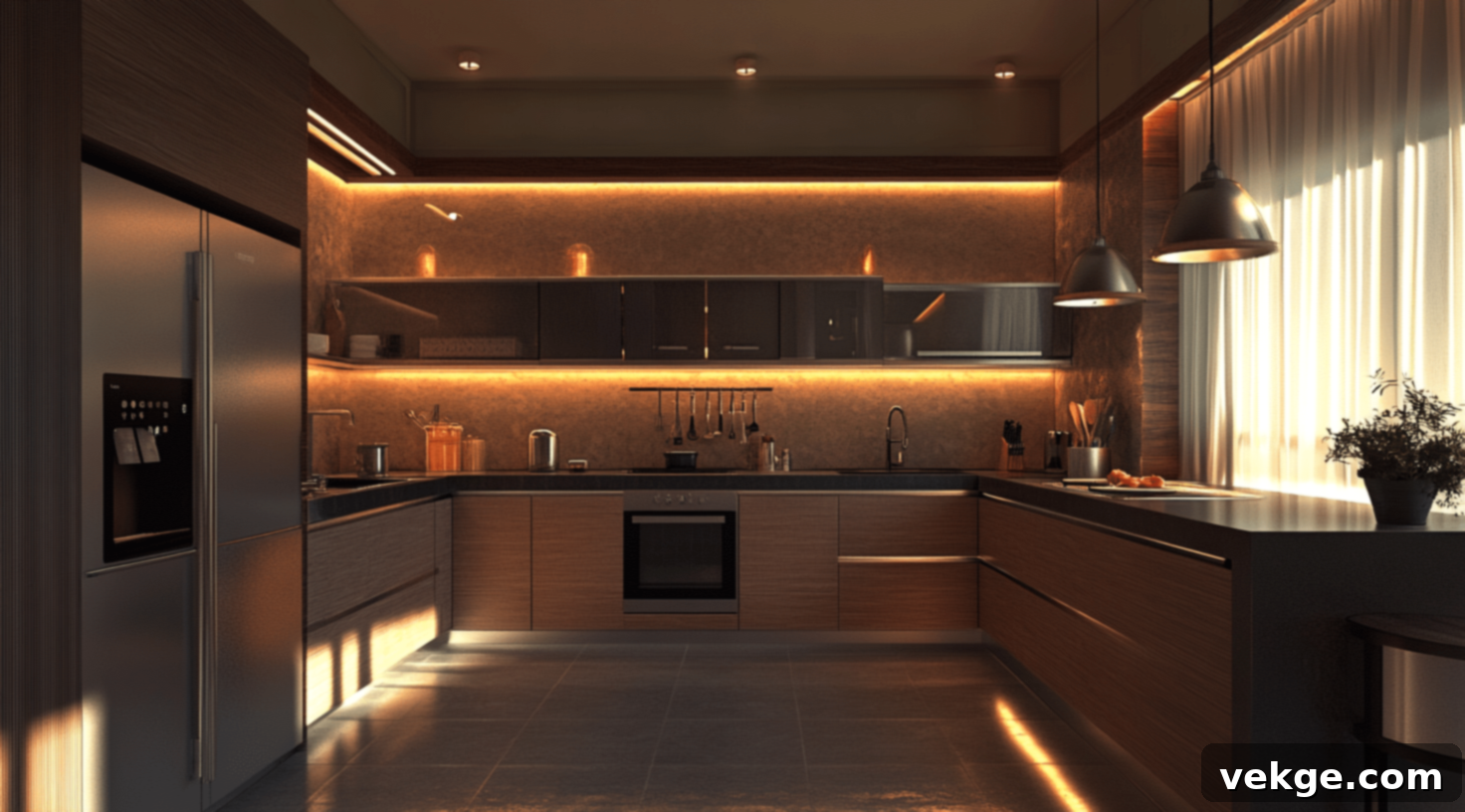Ultimate Guide to Kitchen Lighting: 17 Brilliant Ideas for Every Style & Budget
Are you yearning for a brighter, more inviting kitchen? A space that’s not just functional but also a joy to spend time in? If your current kitchen lighting leaves something to be desired, casting shadows where you need light most, or simply failing to inspire, then you’re in the right place. Good lighting isn’t just about visibility; it fundamentally shapes the atmosphere, efficiency, and overall aesthetic of your culinary hub. It can turn mundane tasks into pleasant experiences and make your kitchen the true heart of your home.
Finding the perfect lighting setup, however, can often feel overwhelming. With countless options available, how do you choose what’s right for your unique space and personal style? Don’t worry; I’ve got you covered. In this comprehensive guide, I’ll walk you through 17 of the best kitchen lighting ideas for 2024. These carefully selected tips and tricks will help you create a beautifully lit, welcoming kitchen that’s perfectly suited for cooking, dining, entertaining, and simply gathering with loved ones.
From ingenious under-cabinet solutions that illuminate your workspaces to stunning statement pendant lights that become the focal point of your design, we’ll explore a diverse range of options for every style, need, and budget. Get ready to banish those dim corners and infuse your kitchen with light and life. Let’s dive in and discover the perfect lighting ideas to brighten up your space!
Top 17 Kitchen Lighting Ideas to Illuminate Your Home
1. Under-cabinet LED Strips: Brighten Your Workspace
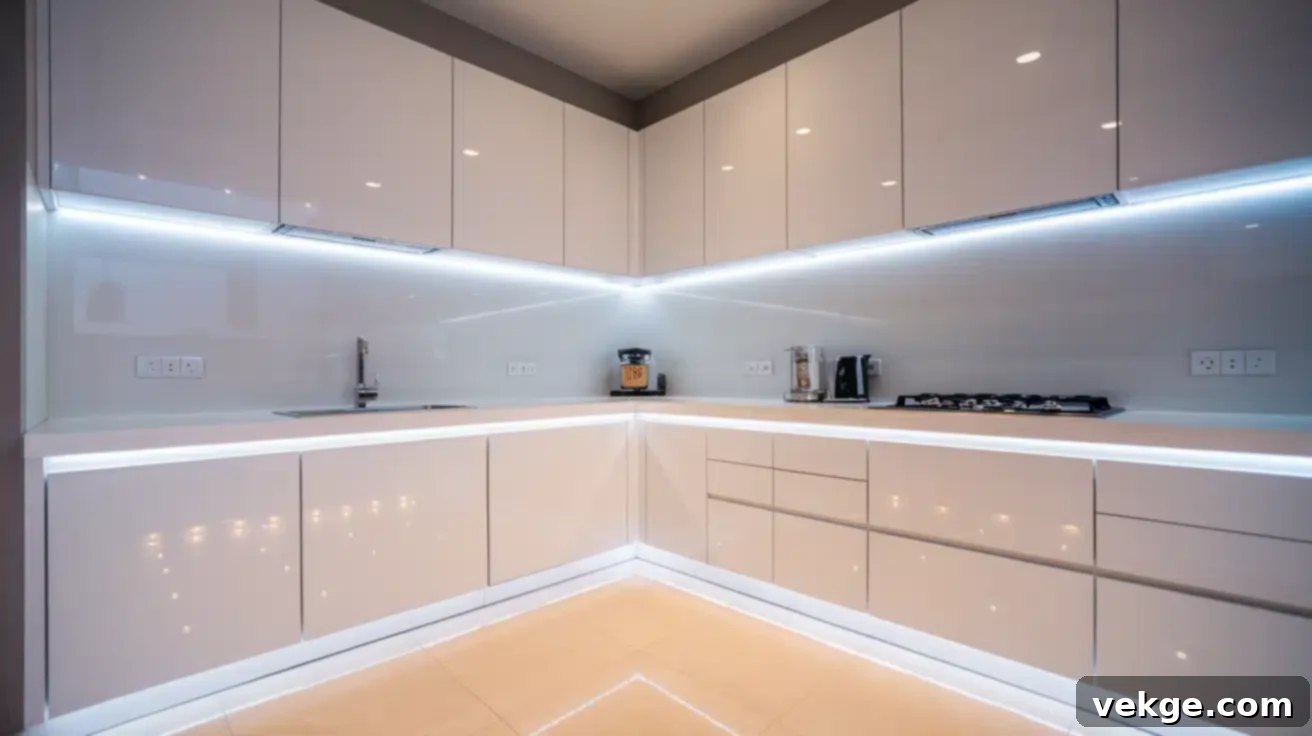
Why I Consider This Idea: I absolutely adore under-cabinet LED strips because they seamlessly blend both style and unparalleled functionality into any kitchen. They are a game-changer for task lighting, directly illuminating your countertops, which makes food preparation safer, easier, and more enjoyable. Beyond their practical benefits, these sleek strips imbue the kitchen with a modern, sophisticated aesthetic, creating a continuous, elegant glow that truly enhances the space.
Benefits:
- Superior Task Lighting: Provides bright, even illumination directly onto your countertops, eliminating shadows and enhancing visibility for cooking and prep work.
- Energy-Efficient & Long-Lasting: LED technology means these strips consume very little power and have an incredibly long lifespan, saving you money on electricity bills and frequent bulb replacements.
- Low Heat Output: Unlike traditional lighting, LEDs produce minimal heat, making them safe for installation under cabinets and near food items.
- Versatile Ambiance: Many models offer color-changing capabilities or adjustable white temperatures, allowing you to customize the mood of your kitchen from a crisp cool white to a warm, inviting glow.
- Enhanced Spaciousness: The upward glow from under-cabinet lighting can make your kitchen appear larger, more open, and airier, particularly when paired with reflective surfaces.
- Easy Installation: Many LED strip kits are designed for DIY installation, often with adhesive backing, making them a relatively simple and impactful upgrade.
Longevity: One of the standout features of LED strips is their impressive lifespan. With proper care and quality products, LED strips can last up to 50,000 hours. To put that into perspective, if you use them for an average of 12 hours a day, they could last for over 11 years! This makes them an incredibly durable and long-term lighting solution that won’t require frequent maintenance or costly replacements, ensuring your kitchen stays brilliantly lit for years to come.
2. Pendant Lights Over the Kitchen Island: Stylish Focal Points
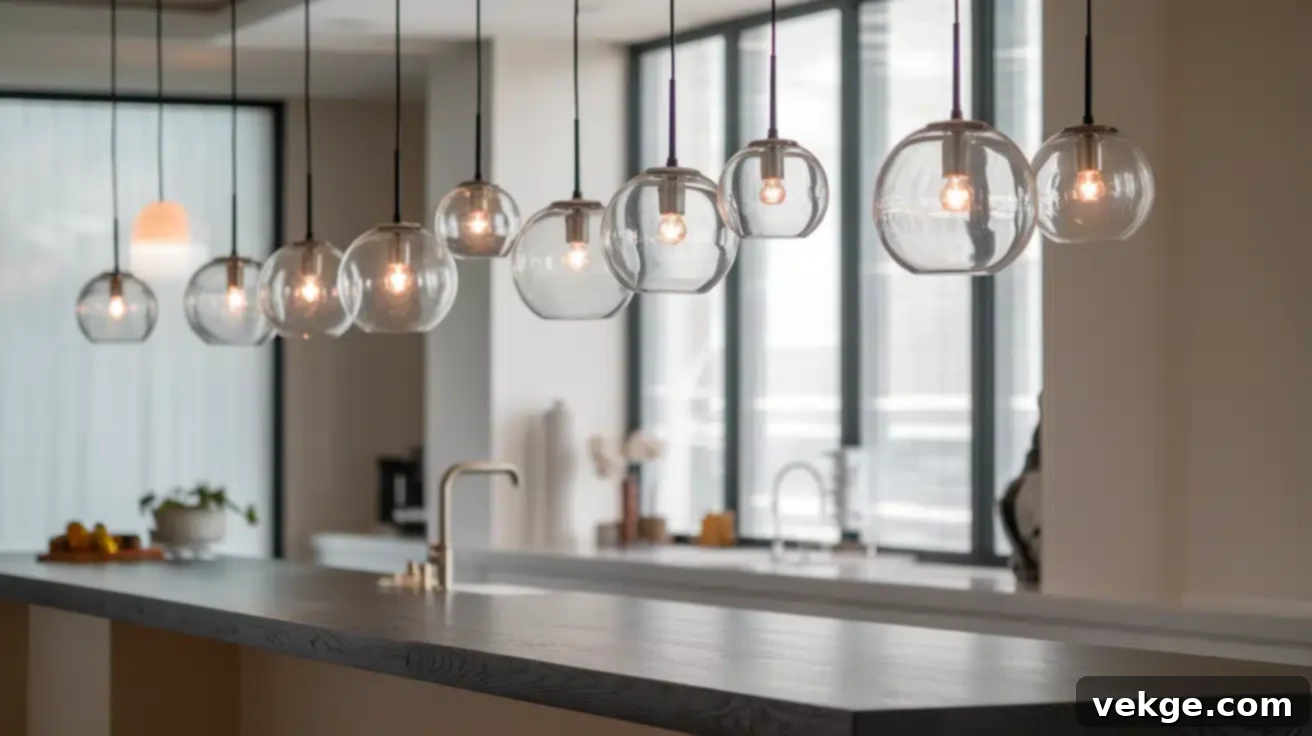
I’m a big fan of strategically placed pendant lights over kitchen islands. They are far more than just light sources; they act as stunning design elements. Not only do they provide essential focused lighting for tasks like food preparation, casual dining, or helping with homework, but they also serve as a stylish focal point, drawing the eye and adding character to the kitchen. I’ve personally found that the right set of pendants can brilliantly tie the entire room’s design together, creating a cohesive and inviting look.
When selecting pendant lights, consider the size of your island and the overall style of your kitchen. For longer islands, a series of two or three smaller pendants often works best, while a single, larger pendant can make a bold statement over a smaller island or a round breakfast nook.
| Option | Ideal For | Material Choices | Popular Styles | Price Point (Fixture Only) |
|---|---|---|---|---|
| Single Pendant | Small islands, targeted task lighting, minimalist designs | Metal, Glass, Wood, Ceramic | Industrial, Modern, Farmhouse, Scandinavian | $50 – $150 |
| Multi-Light Pendants | Larger islands, creating a grander statement, even light distribution | Metal, Glass, Wood, Fabric | Industrial, Modern, Farmhouse, Transitional | $150 – $400+ |
Longevity: The lifespan of pendant lights primarily depends on the type of bulb you choose. If you opt for modern LED bulbs, they can last an impressive 25,000 hours or even more. This means you won’t be changing bulbs frequently. The pendant fixtures themselves are generally very durable and, with proper installation and care, can easily last for many years – often for the entire lifespan of your kitchen. This combination of long-lasting bulbs and robust fixtures makes pendant lights a practical and enduring choice that marries long-term functionality with timeless style.
3. Recessed Ceiling Lights: Seamless and Efficient
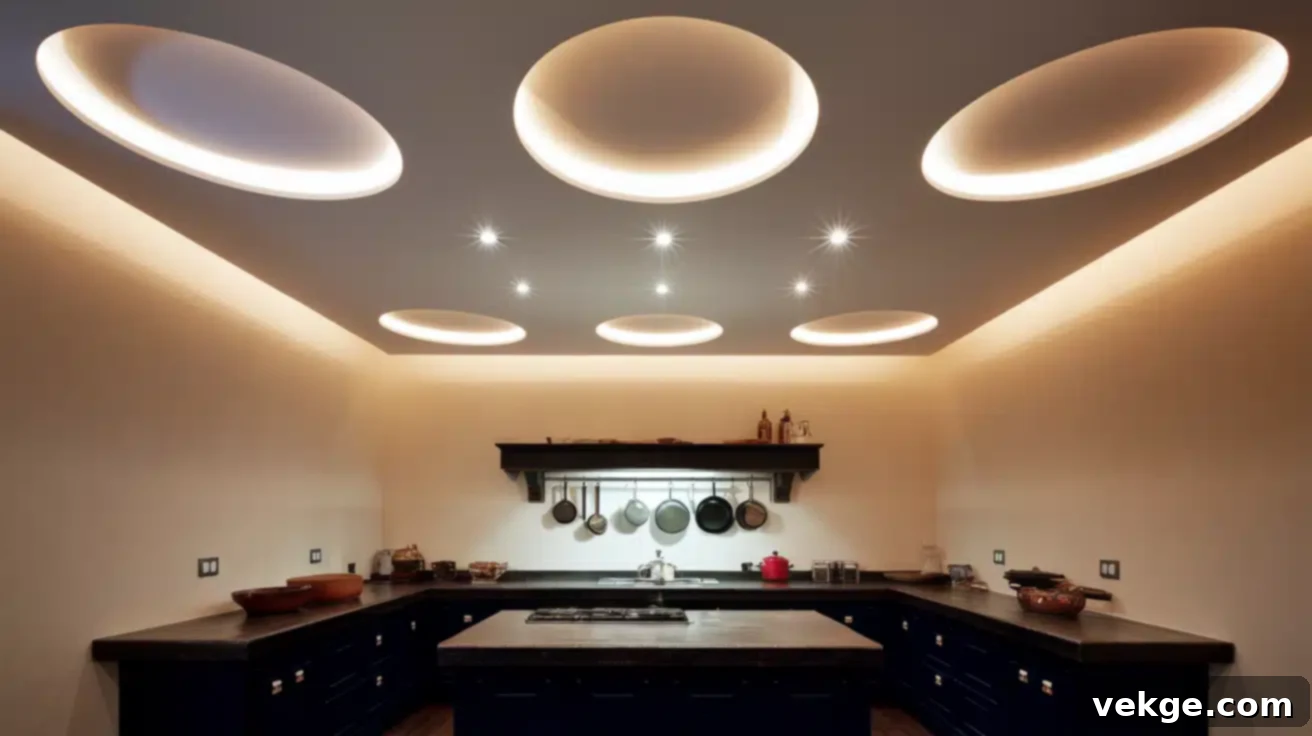
When I redesigned my kitchen a few years back, I opted for recessed ceiling lights, and I’ve got to say, it’s been an absolute game-changer. Just imagine: you walk into your kitchen, flip a switch, and the entire room lights up evenly and beautifully. No harsh glare, no dark corners, just a warm, welcoming glow that makes you want to whip up a gourmet meal or simply enjoy a quiet cup of coffee. That’s the power of well-planned recessed lighting.
Now, I know what some of you might be thinking: “Aren’t they a bit boring or too understated?” Trust me, I had similar thoughts initially. But here’s the thing – recessed lights are like the perfect backup singers. They don’t steal the show, but they make everything else look better. Your elegant countertops, that cool backsplash you picked out, and even your artful fruit bowl all truly pop under the consistent, clean illumination provided by recessed lighting. They offer a clean, uncluttered look, making your ceiling appear higher and your kitchen feel more expansive.
And let’s talk practicality. I’m on the taller side, and I can’t tell you how many times I’ve nearly bumped my head on hanging fixtures in other kitchens. With recessed lights, that’s one less thing to worry about. Plus, they’re incredibly easy to clean – no dusty lampshades or intricate designs to maintain! They offer superior general lighting and can be strategically placed to provide task lighting where needed, making them incredibly versatile.
Longevity: When paired with energy-efficient LED bulbs, recessed lights can last an astonishing 50,000 hours or even more. For average household use, that translates to approximately 20 years! The fixtures themselves, assuming proper installation and quality components, can easily last for the entire lifetime of your kitchen. This makes recessed lighting a wise, long-term investment, providing a reliable and stylish lighting solution that combines superior function with enduring appeal.
4. Track Lighting for Flexible Illumination: Adaptable and Modern
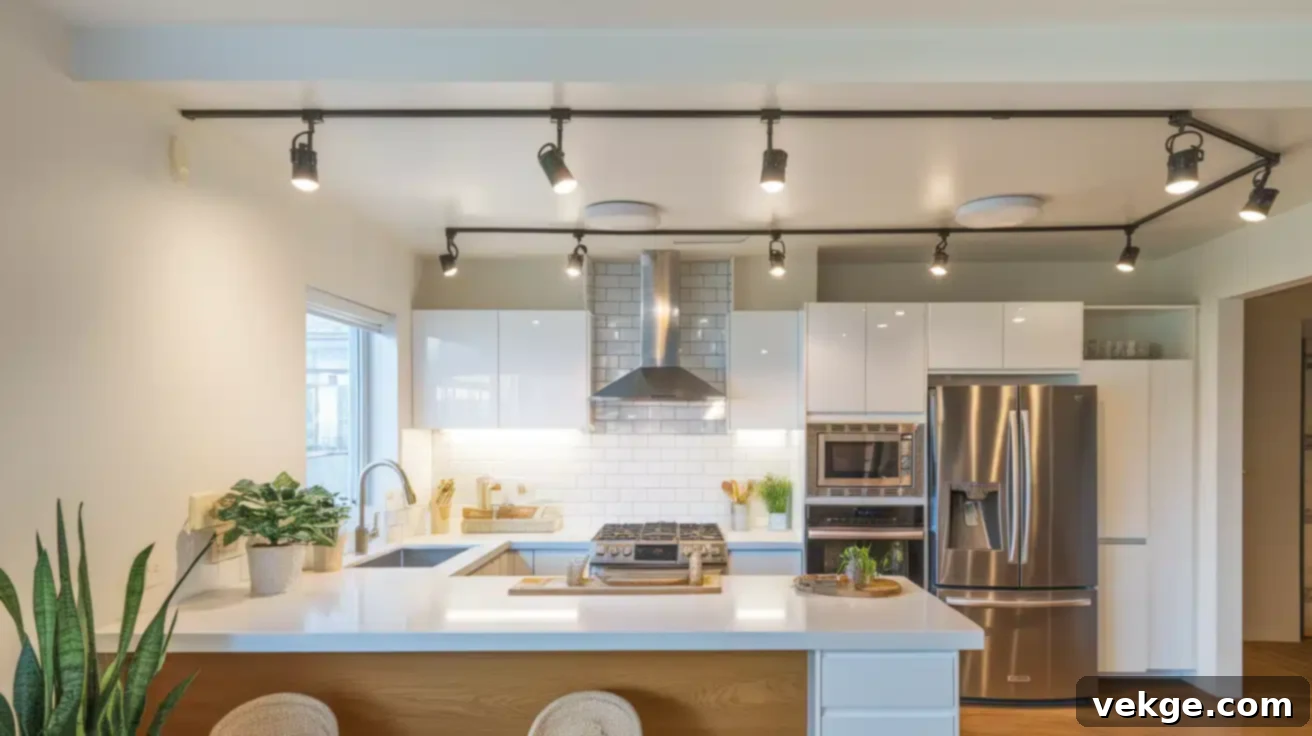
Why I Consider This Idea: I find track lighting to be an incredibly versatile and effective solution for kitchens, primarily because it offers unmatched flexibility. The ability to adjust the direction and focus of light exactly where it’s needed is perfect for the dynamic nature of a kitchen, where tasks and lighting requirements can vary significantly throughout the day. Whether you’re chopping vegetables, highlighting a piece of art, or simply needing general ambient light, track lighting adapts effortlessly.
| Type of Track Lighting | Price Range (System) | Description |
|---|---|---|
| Linear Track System | $100 – $300 | The most common type, excellent for providing continuous lighting over long kitchen counters or islands. Easily extendable. |
| Flexible Track System | $150 – $400 | Can be gently bent and shaped to fit curved ceilings or unique, non-linear kitchen layouts, offering customizability. |
| Monorail Track System | $200 – $500 | Features a sleek, single rail design that can be shaped. Offers a more contemporary and refined aesthetic, ideal for modern kitchens. |
| Cable Track System | $250 – $600 | Uses thin, suspended cables for a minimalist and almost invisible look, working exceptionally well in industrial-style or very open kitchens. |
| LED Track Lighting | $150 – $450 | Specifically designed for energy-efficient LED bulbs, offering a wide variety of color temperatures and beam angles for precise illumination. |
Benefits:
- Unrivaled Adjustability: Effortlessly pivot, rotate, and aim individual light heads to illuminate specific areas, countertops, or decorative features as your needs change.
- Space-Saving Design: Unlike bulky hanging fixtures, track lighting maintains a clean ceiling line, making it ideal for kitchens with lower ceilings or those that desire an uncluttered look.
- Multi-functional: Capable of providing task lighting for detailed work, accent lighting to highlight architectural features or artwork, and general illumination to brighten the entire room.
- Scalable & Adaptable: You can easily add or remove light heads, or even extend the track, without requiring major electrical re-wiring, making future adjustments simple.
- Aesthetic Versatility: Available in a vast array of designs, finishes, and head styles, track lighting can complement various kitchen decors, from industrial to ultra-modern.
Longevity: Track lighting systems are built to last, with the tracks themselves often enduring 20-30 years with proper installation and occasional maintenance. The individual light fixtures (the heads) typically have a lifespan of 10-15 years, and their modular nature means they can be replaced independently. If you choose LED bulbs for your track lighting, which are highly recommended, they can last an impressive 50,000 hours or approximately 20 years with average daily use. Simple maintenance, such as regular dusting of the fixtures and ensuring all connections are secure, will help maximize the system’s lifespan, making track lighting a smart and cost-effective investment for long-term kitchen illumination.
5. Chandelier for a Statement Piece: Elegance and Grandeur
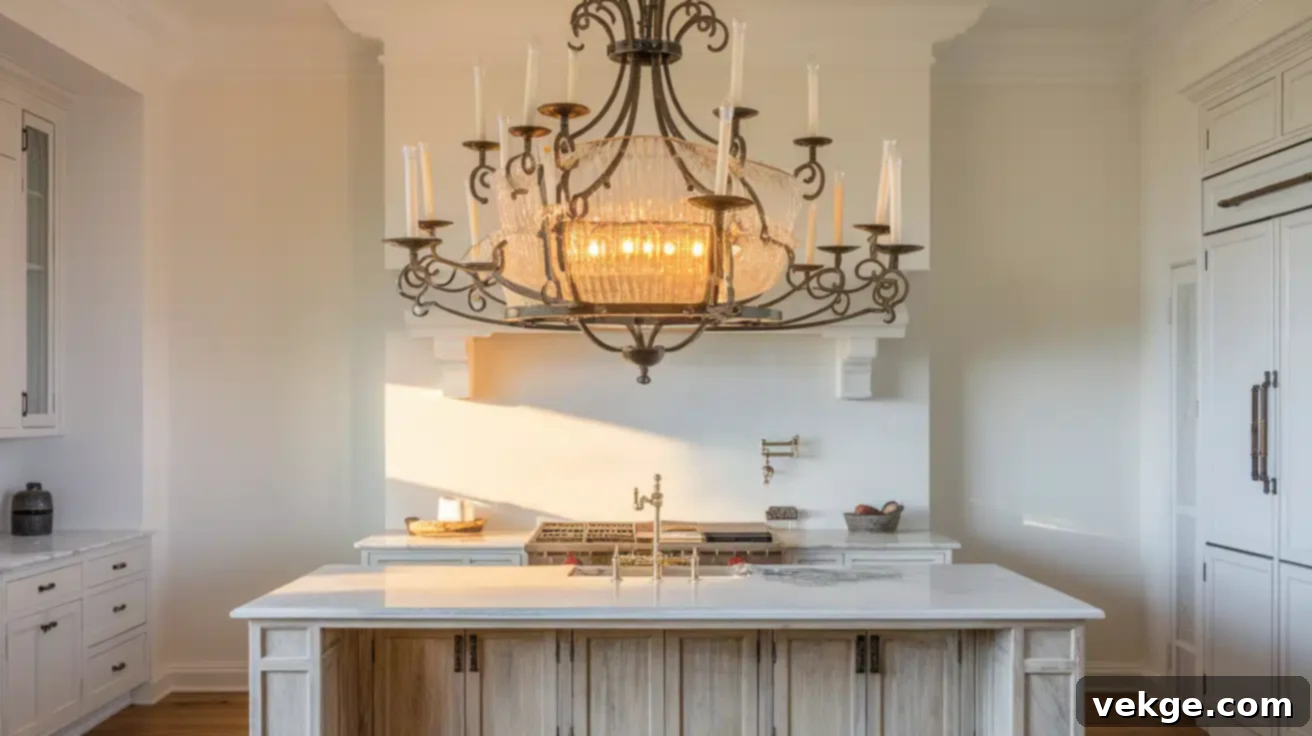
For those looking to inject a serious dose of glamour and sophistication into their kitchen, a chandelier can be the ultimate choice. It goes beyond mere illumination; a well-chosen chandelier instantly transforms into the room’s central focal point, tying together your kitchen’s design and making it feel less like a purely utilitarian cooking area and more like a luxurious living space. I absolutely love the idea of incorporating a chandelier into the kitchen because it introduces an element of unexpected elegance and a strong dose of personality. It’s a bold statement that can elevate a functional area into a breathtaking showstopper.
When selecting a chandelier for your kitchen, consider its size in proportion to the room and your island or dining area. Modern kitchens can benefit from minimalist, geometric designs, while traditional or farmhouse kitchens might shine with rustic iron or crystal fixtures. Ensure it provides adequate ambient light, and consider pairing it with dimmers to adjust the mood. It’s an investment in style that pays off every time you enter the room.
Longevity: The longevity of a chandelier fixture itself is exceptional; a high-quality piece can last for decades, often becoming a cherished heirloom. The bulbs, of course, will need periodic replacement. Opting for LED bulbs within your chandelier will drastically extend the time between changes, with LEDs lasting upwards of 25,000 hours. The key is choosing a well-constructed fixture and maintaining it properly, ensuring this stunning piece remains a highlight of your kitchen for many, many years.
6. Task Lighting Near Work Areas: Precision and Safety
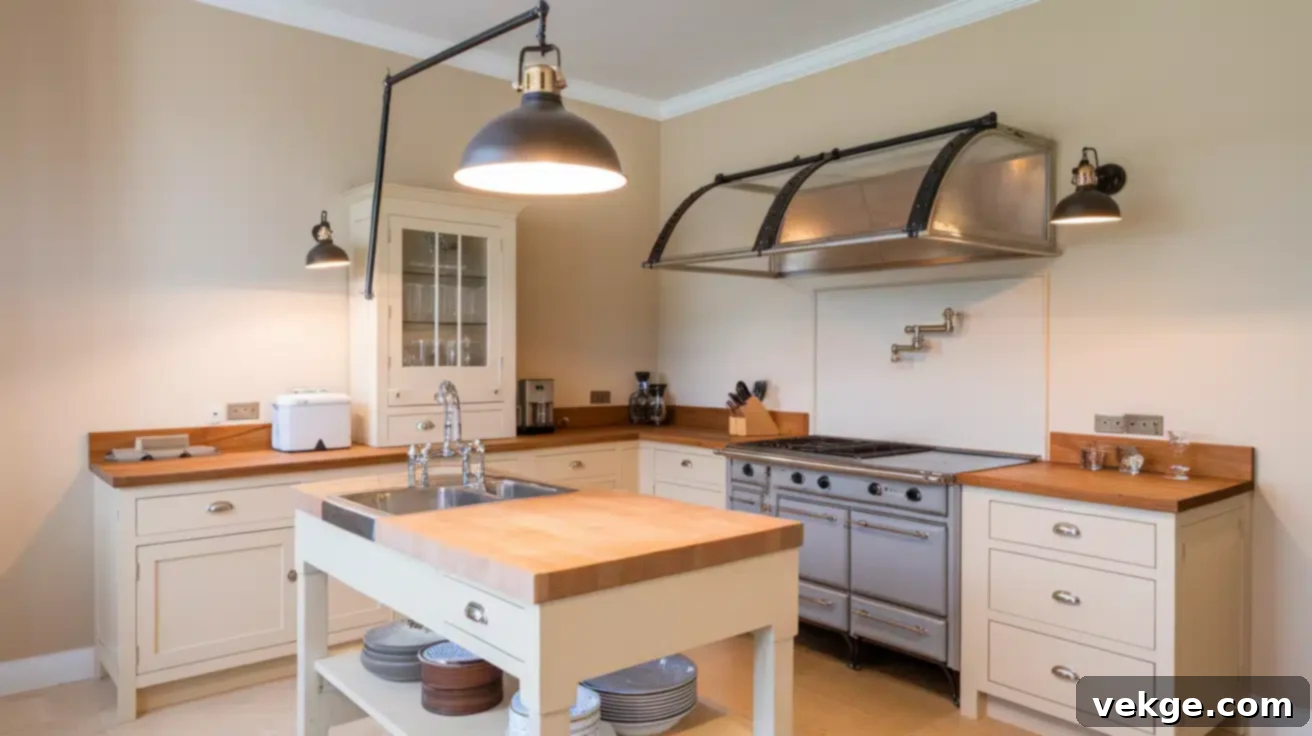
Task lighting is all about putting light precisely where you need it most. In my kitchen, I’ve strategically added lights under the cabinets, directly above the primary prep areas. This targeted illumination shines right onto the countertop, making activities like chopping vegetables, reading recipes, or kneading dough significantly easier and much safer. There’s no more squinting or dealing with frustrating shadows cast by overhead fixtures while I’m engrossed in my culinary tasks!
Benefits:
- Better Visibility: I can clearly see every detail when I’m performing intricate kitchen tasks, reducing the chances of errors and enhancing the quality of my cooking.
- Safer Food Prep: Good, direct lighting is crucial for safety, especially when using sharp knives or operating kitchen appliances. It helps prevent accidents by ensuring clear visibility.
- Easier Cleaning: Well-lit areas make it much simpler to spot crumbs, spills, and messes, ensuring a thoroughly clean workspace after every use.
- Improved Mood & Focus: Bright and focused work areas can make kitchen tasks feel less like chores and more enjoyable, boosting overall productivity and satisfaction.
- Energy Efficiency: By using targeted task lighting, I can often keep the overall ambient kitchen lighting at a lower level, which contributes to energy savings.
- Reduces Eye Strain: Adequate task lighting prevents eye fatigue that can occur from working in dim or poorly lit conditions.
Longevity: The lifespan of task lighting largely depends on the type of bulb. For most task lighting, such as under-cabinet puck lights or linear LEDs, you’ll typically be using LED technology. These bulbs boast an impressive lifespan of 25,000 to 50,000 hours, meaning they could last for over a decade with regular use. The fixtures themselves are generally very durable and, once installed, require minimal maintenance beyond occasional cleaning.
7. Over-Sink Lighting: Illuminating Essential Chores
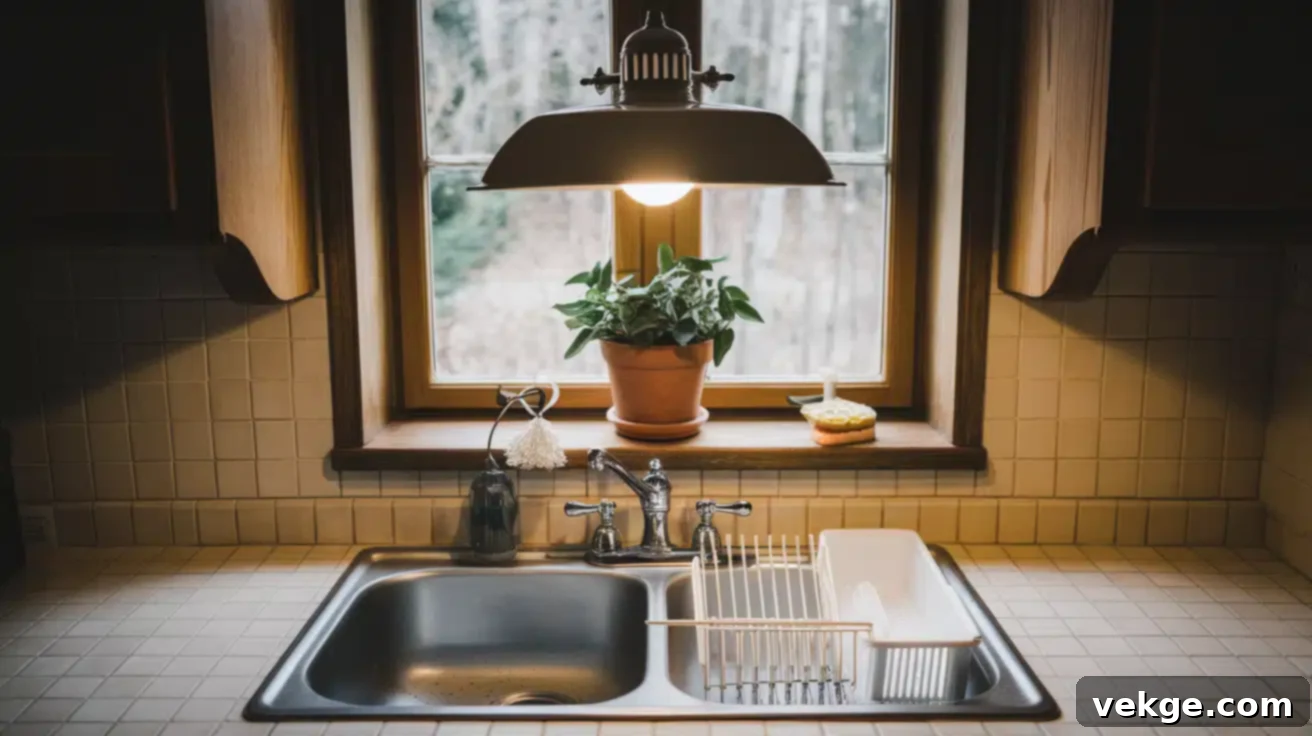
Why I Consider This Idea: When I’m washing dishes, cleaning produce, or performing other tasks at my kitchen sink, I often found myself working directly in my own shadow. That’s when I realized how critically important dedicated over-sink lighting is. It’s a seemingly small addition that has made a profoundly big difference in the functionality and comfort of my kitchen. It transforms a dark, often neglected area into a bright and efficient workspace.
Benefits:
- Improved Visibility: Direct light illuminates the sink basin and surrounding countertop, making it easier to see dirt, food particles, and ensure thorough cleaning.
- Fewer Missed Spots: No more guessing if a dish is truly clean; the bright light reveals all.
- Easier Food Prep: Many people use the sink area for washing and prepping vegetables. Targeted lighting here is essential for safety and precision.
- Reduced Eye Strain: Working in shadow can cause eye fatigue. Good over-sink lighting alleviates this, making tasks more comfortable.
- Added Style: A stylish pendant, flush mount, or even a discreet recessed light above the sink can enhance the overall aesthetic of your kitchen.
Remember, if you’re not entirely confident about handling electrical work yourself, it’s always safest and best to hire a professional electrician for installation. However, for those who are handy with DIY projects, installing over-sink lighting can be a highly rewarding upgrade. It’s truly made my time at the sink much more pleasant and productive!
Longevity: The durability of over-sink lighting depends on the fixture and bulb. With modern LED fixtures, you can expect a lifespan of 25,000 to 50,000 hours, meaning very infrequent bulb changes. Even with traditional bulbs, the fixture itself is designed to last many years, often exceeding a decade with minimal care. Opt for damp-rated fixtures if condensation is a concern for maximum lifespan.
8. Illuminated Shelving: A Dazzling Display

Why I Consider This Idea: I absolutely love illuminated shelving because it adds an undeniable “wow” factor to my kitchen. It’s not just about adding light; it’s about creating a sophisticated display that makes the entire space feel larger, brighter, and incredibly chic. It truly elevates the design from ordinary to extraordinary.
Benefits: Not only does it brilliantly light up my favorite dishes, glassware, and decorative items, turning them into a curated exhibit, but it also serves a practical purpose. It significantly helps me find things easily, especially when I’m reaching for a specific ingredient or piece of tableware during late-night cooking sessions or when hosting guests. It adds both aesthetic appeal and convenient functionality.
| Type | Description | Ideal For |
|---|---|---|
| LED Strip Lighting | Flexible and discreet, these strips are simple to install and can be placed under or along the front edge of each shelf for consistent, even lighting across the entire display. | Most shelving types (wood, glass); highly energy-efficient, offers uniform and modern illumination. |
| Puck Lights | Small, round, and often battery-operated or low-voltage lights mounted underneath or above shelves. Provides focused pools of light. | Highlighting specific items; creating individual spot lighting for a dramatic effect. |
| Backlit Shelving | Light panels or strips are installed behind the shelf (often within the cabinet structure) to create a soft, ambient glow that emanates from the back. | Glass or acrylic shelves; adds a modern, luxurious, and ethereal look, making the shelves appear to float. |
Longevity: The LED lights typically used for illuminated shelving are incredibly durable and long-lasting, often boasting a lifespan of 50,000 hours or more. This means that if you use them for an average of 8 hours a day, they could last for approximately 17 years! It’s a low-maintenance, high-impact investment that will continue to dazzle for years.
9. Skylight for Natural Light: Embracing the Outdoors
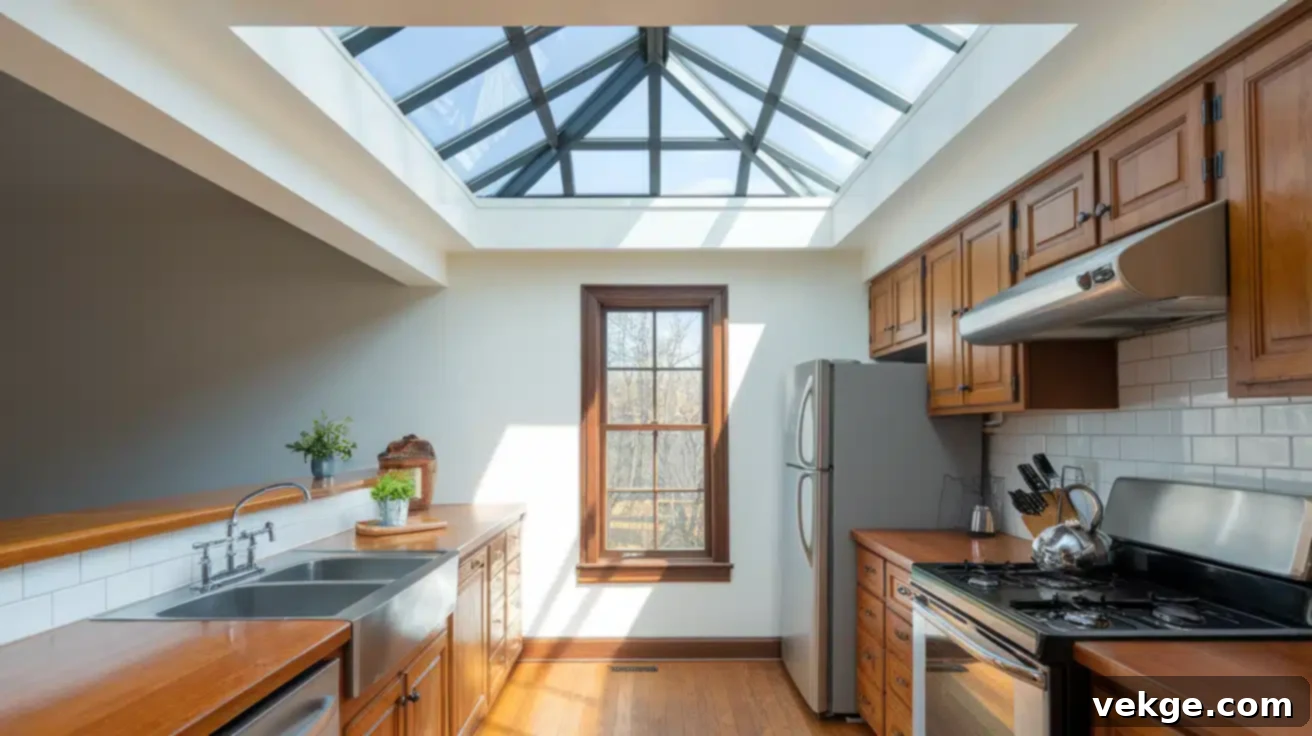
Why I Consider This Idea: I am a huge advocate for incorporating as much natural light as possible into any living space, and the kitchen is no exception. A skylight profoundly transforms a kitchen, making it feel significantly more open, airy, and connected to the outdoors. It brings a sense of freshness and vitality that artificial lighting simply cannot replicate.
Benefits: Beyond the immediate aesthetic appeal, a skylight offers numerous practical advantages. It substantially cuts down on my electric bill during daylight hours, as there’s less need for artificial lighting. Moreover, natural light has a remarkable effect on food presentation, making ingredients and prepared dishes look far more vibrant and appealing. Perhaps most importantly, the influx of natural light has a proven positive impact on mood, boosting energy levels and overall well-being. It can also help circulate air if it’s a venting model.
How to Install This: It’s important to note that installing a skylight is indeed a significant undertaking. It’s not a typical DIY project for most homeowners, as it involves cutting a hole in your roof, ensuring structural integrity, proper flashing, and watertight sealing. For these critical reasons, I would strongly recommend hiring a qualified, experienced professional contractor or roofer to handle the installation. Their expertise will ensure the skylight is correctly installed, preventing leaks and structural issues, and maximizing its long-term benefits.
Longevity: A high-quality skylight, when properly installed and maintained, can be a very long-term investment, typically lasting anywhere from 20 to 30 years. Modern skylights are designed with durable materials and advanced sealing techniques to withstand the elements. Occasional cleaning and inspection of the seals will help ensure its longevity and continued performance.
10. Dimmer Switches for Adjustable Ambiance: Control Your Mood
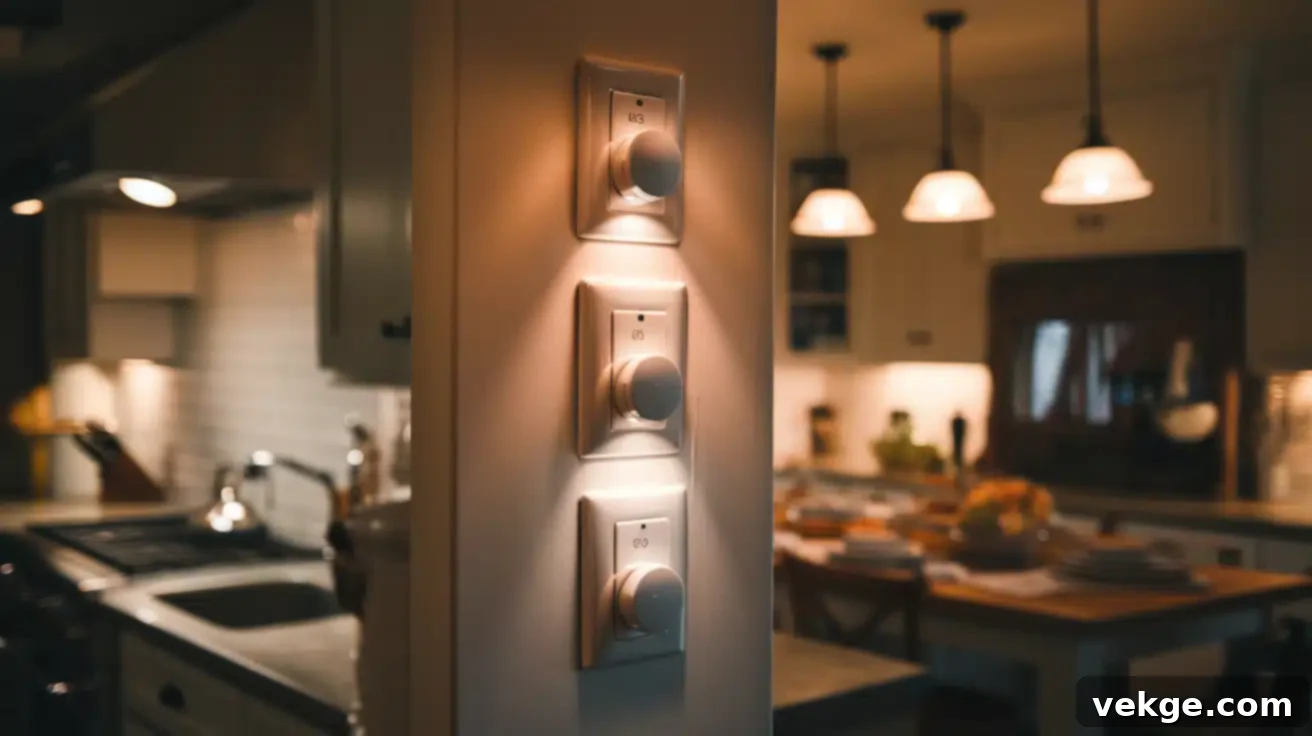
Why I Consider This Idea: One of the simplest yet most impactful upgrades you can make to your kitchen lighting is installing dimmer switches. I personally love having complete control over my lighting environment. Sometimes, I need bright, invigorating light for precise cooking tasks, and other times, I much prefer a softer, more subtle glow to set a relaxed atmosphere for dining or evening unwinding.
Benefits: The primary benefit is the incredible flexibility they offer. They help me effortlessly create the right mood and ambiance for any occasion, whether it’s a lively family dinner, a romantic evening, or a quiet morning coffee. Beyond mood-setting, dimmers also contribute significantly to energy efficiency. By allowing me to reduce the light output when full brightness isn’t needed, they can lead to noticeable savings on electricity bills. Additionally, dimming bulbs can actually extend their lifespan, especially for incandescent and halogen types, further adding to their value. It’s a small change that offers a huge return in terms of comfort, versatility, and cost savings.
Longevity: Most high-quality dimmer switches are designed to be durable and can easily last for approximately 15 years, or even longer with careful use. They are a robust and relatively inexpensive upgrade that offers continuous benefits throughout their lifespan, making a significant difference in how you experience your kitchen’s lighting.
11. Wall Sconces for Accent Lighting: Elegant Wall Art
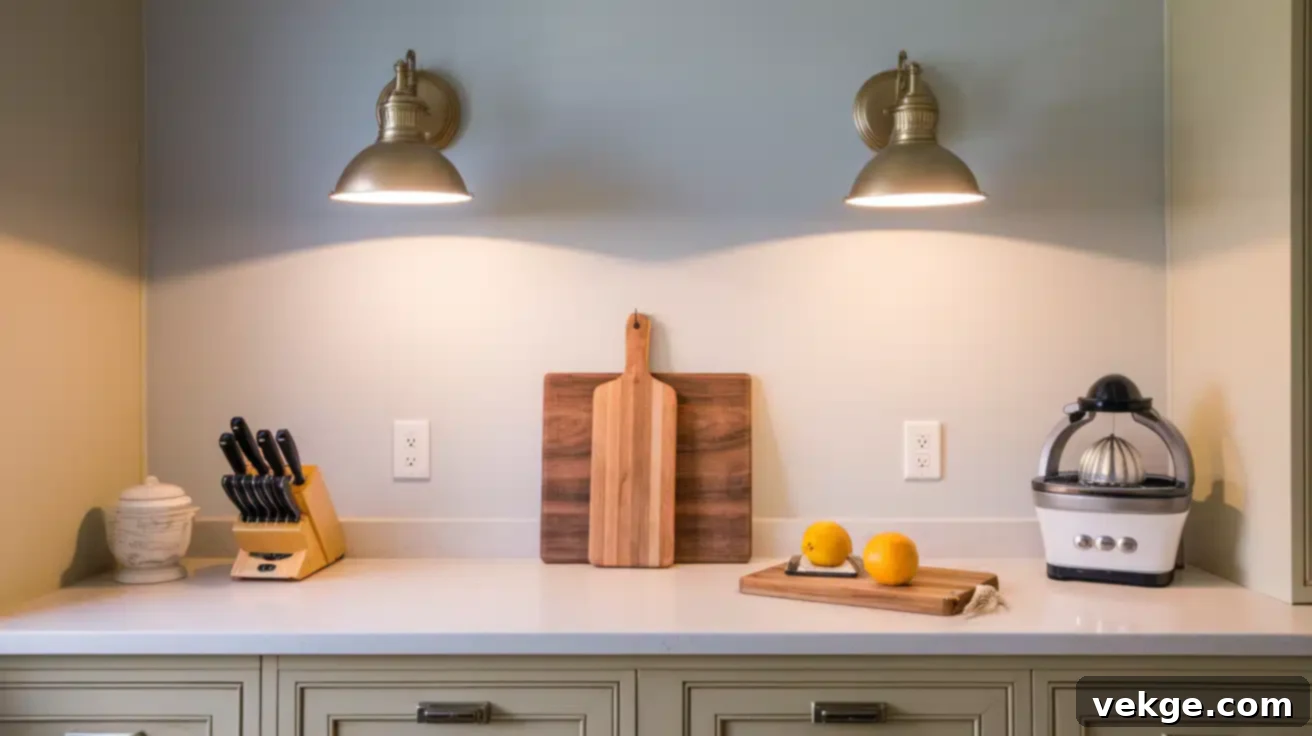
Why I Consider This Idea: Wall sconces are a fantastic way to introduce an element of sophisticated charm and elegance into my kitchen. They move beyond purely functional lighting to become decorative features themselves. They excel at creating a warm, inviting, and layered lighting scheme that makes the kitchen feel more refined and welcoming, especially during evening hours.
Benefits: Sconces provide a beautiful soft, indirect light that washes the walls, creating a comforting glow that’s perfect for evenings or setting a relaxed mood. They are also incredibly effective at drawing attention to my kitchen’s best features, whether it’s a beautiful backsplash, open shelving, or architectural details. They add depth and character to the room without taking up valuable counter or ceiling space, enhancing both the aesthetic and the overall ambiance.
How to Install This: For wired sconces, which typically offer the most seamless look, you’ll need to run electrical wiring within the wall, so it’s generally best to hire a qualified electrician to ensure safety and proper installation. However, if you’re not keen on extensive wiring work, there are some excellent plug-in sconce options available that simply require a nearby outlet and can be a great DIY alternative, offering similar stylistic benefits with easier installation. Always ensure proper spacing and height for the best effect.
Longevity: With good quality fixtures and proper care, wall sconces can easily last 15-20 years, becoming a timeless and integral part of your kitchen’s design. The bulbs, particularly if you choose LEDs, will last for many years before needing replacement, ensuring consistent illumination and minimal upkeep for this elegant addition.
12. Toe Kick Lighting for Subtle Glow: Modern & Functional

I genuinely appreciate the subtle elegance and surprising functionality of toe kick lighting. This clever application of light at floor level adds a distinct modern touch to the kitchen, making the cabinetry appear as if it’s gently floating. It’s not just for aesthetics; it also provides a soft, guiding light that helps me navigate the kitchen safely at night without having to turn on brighter, more disruptive overhead lights.
Benefits: Toe kick lighting creates a beautiful floating effect for cabinets, giving the room a sleek and contemporary edge. It also adds a wonderful layer of depth and interest to the room’s design. Functionally, it’s incredibly helpful for safety, gently illuminating the floor path during late-night trips to the fridge or for children and pets, without being overly bright or jarring. It’s an understated detail that makes a big impact on both style and practicality.
| Type | Ideal For | Price Range (Materials Only) |
|---|---|---|
| LED Strip Lights | Achieving continuous, uniform lighting along the entire base of cabinet runs. Available in various colors and brightness levels, often with adhesive backing for easy installation. | $15 – $50 per strip (typically 16-32 ft) |
| Rope Lighting | Kitchens with curves or unusual shapes, as the rope can be easily molded. Offers a warm, diffused, and softer light compared to direct LED strips. | $10 – $40 per strand (typically 10-20 ft) |
| Puck Lights | Creating distinct spots of light along the toe kicks rather than a continuous glow, useful for highlighting specific sections or a more spaced-out effect. | $5 – $20 per light (often sold in multi-packs) |
Longevity: Just like other LED-based lighting solutions, LED toe kick lights are remarkably durable. They can last up to an impressive 50,000 hours. This means if you use them for an average of 8 hours daily, you can expect them to function flawlessly for approximately 17 years. This outstanding longevity ensures a long-lasting, low-maintenance glow for your kitchen’s base.
13. Ceiling Fan with Integrated Light: Dual Functionality
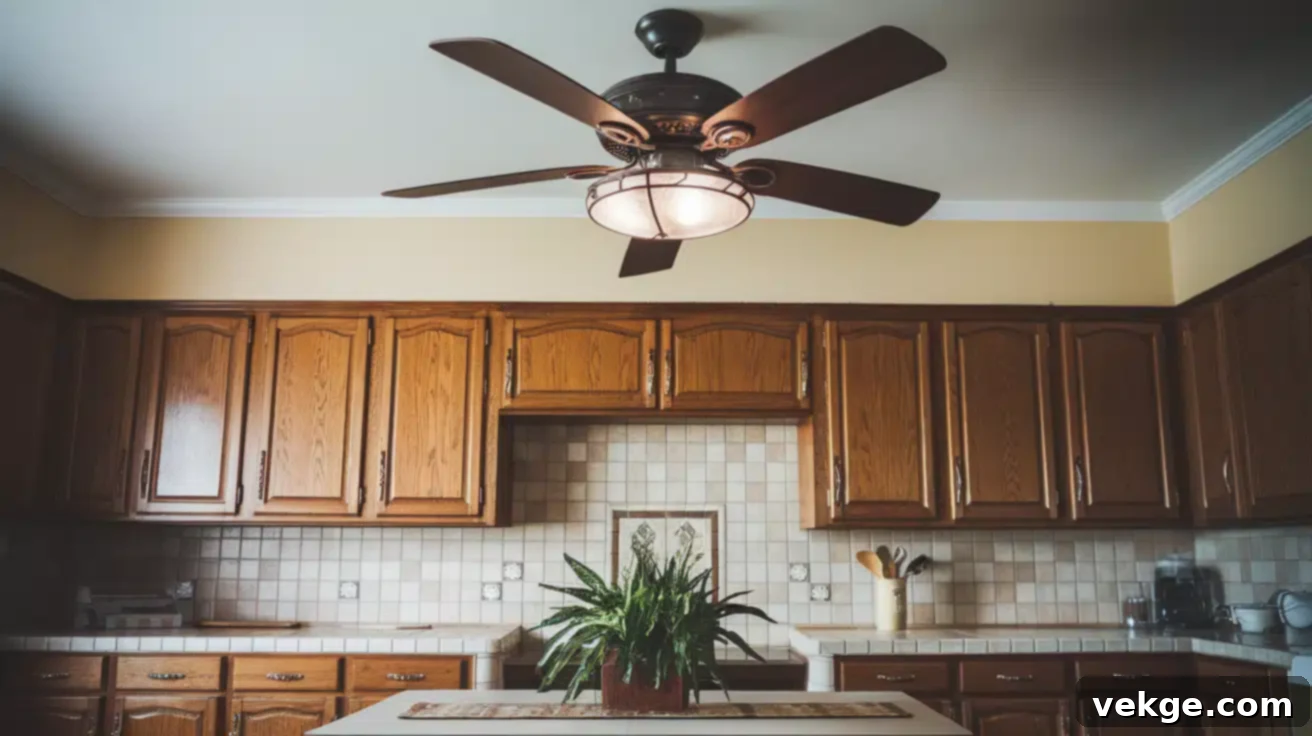
Why I Consider This Idea: I highly value efficient use of space and multi-functional solutions, which is why a ceiling fan with an integrated light is a brilliant idea for many kitchens. It combines two essential elements – lighting and air circulation – into a single, cohesive fixture. This approach is not only practical but also helps to de-clutter the ceiling, especially in kitchens where multiple fixtures might feel overwhelming.
Benefits: This dual-purpose fixture is excellent for keeping my kitchen cool and comfortable, which is especially appreciated when I’m cooking up a storm or during warmer months. The fan circulates air, helping to dissipate heat and odors, while the integrated light provides crucial general illumination for the entire space. It’s a superb choice for enhancing comfort and ensuring the kitchen remains a pleasant environment, regardless of the activity or time of year.
How to Install This: If you’re replacing an existing ceiling light fixture, and the electrical box is rated for ceiling fan support, you might be able to handle the installation yourself with a good set of instructions. However, ceiling fans are heavier and require more stable mounting than simple light fixtures. If there’s no existing wiring, or if you’re unsure about the structural support, I would strongly recommend calling a certified electrician. They will ensure it’s properly supported, securely wired, and adheres to all safety codes.
Longevity: A well-made ceiling fan can last a significant period, typically 10-15 years or even longer with proper maintenance and cleaning of the motor and blades. The light bulbs within the fixture will, of course, need replacing more often, depending on the bulb type (LEDs will last the longest). Regular dusting and ensuring the fan is balanced will contribute to its overall lifespan and efficient operation.
14. Glass Cabinet Lighting: Showcase Your Treasures
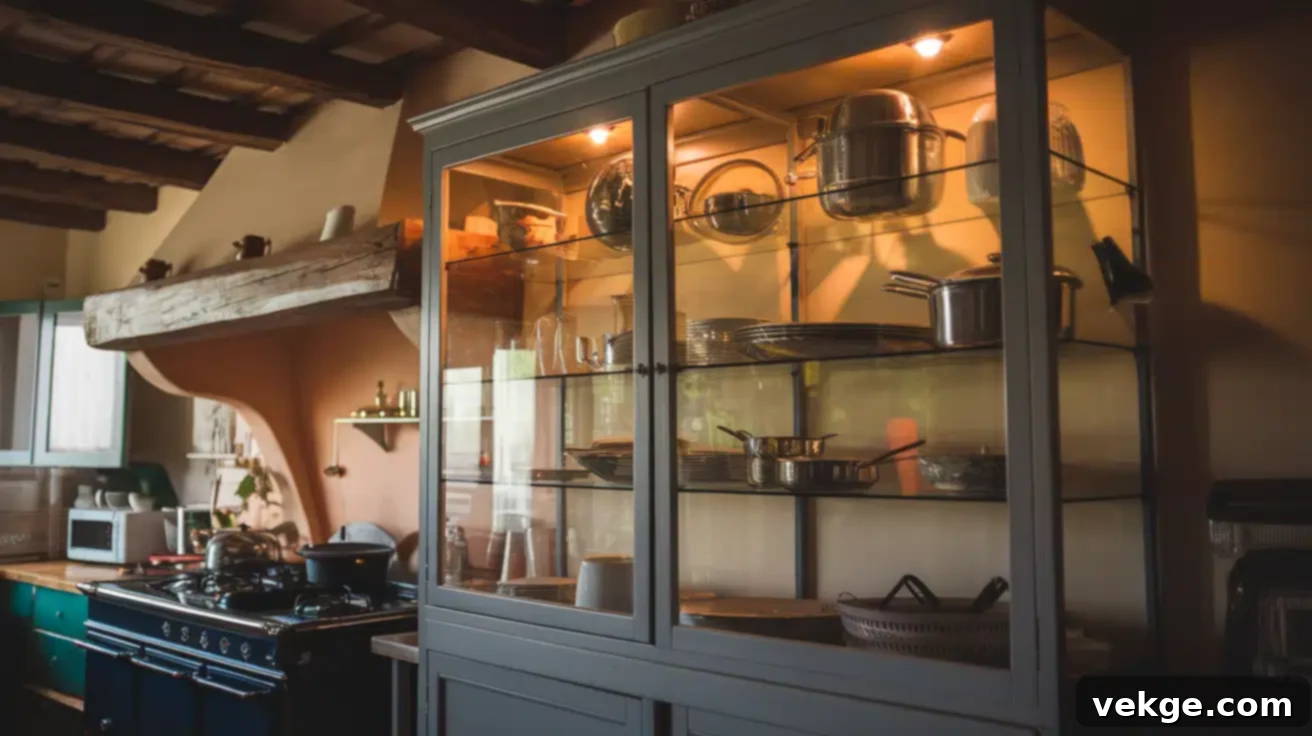
Why I Consider This Idea: I genuinely believe that integrating lighting into glass-front cabinets instantly elevates a kitchen’s aesthetic, making it look incredibly high-end and custom-designed. It’s a fantastic way to showcase beautiful dishes, cherished glassware, or even curated collections, transforming everyday items into decorative elements. This type of lighting adds a layer of sophistication that truly makes the kitchen shine.
Benefits: Beyond the visual appeal, glass cabinet lighting adds significant depth and visual interest to my kitchen, breaking up the monotony of solid cabinet fronts. It also makes it considerably easier to find specific items within my cabinets, especially during darker hours, combining practicality with beauty. Furthermore, the soft glow emanating from these cabinets is perfect for creating a cozy and inviting atmosphere in the evenings, serving as a subtle ambient light that enhances the overall warmth of the room.
Longevity: When using modern LED lighting for glass cabinets (which is highly recommended due to low heat and small size), you can expect exceptional longevity. These LED cabinet lights can last up to an impressive 50,000 hours. If you typically use them for about 8 hours a day, that translates to approximately 17 years of beautiful, illuminated display. This makes them a durable and low-maintenance choice for adding enduring elegance to your kitchen.
15. Rope Lighting for Cove or Crown Molding: Hidden Radiance
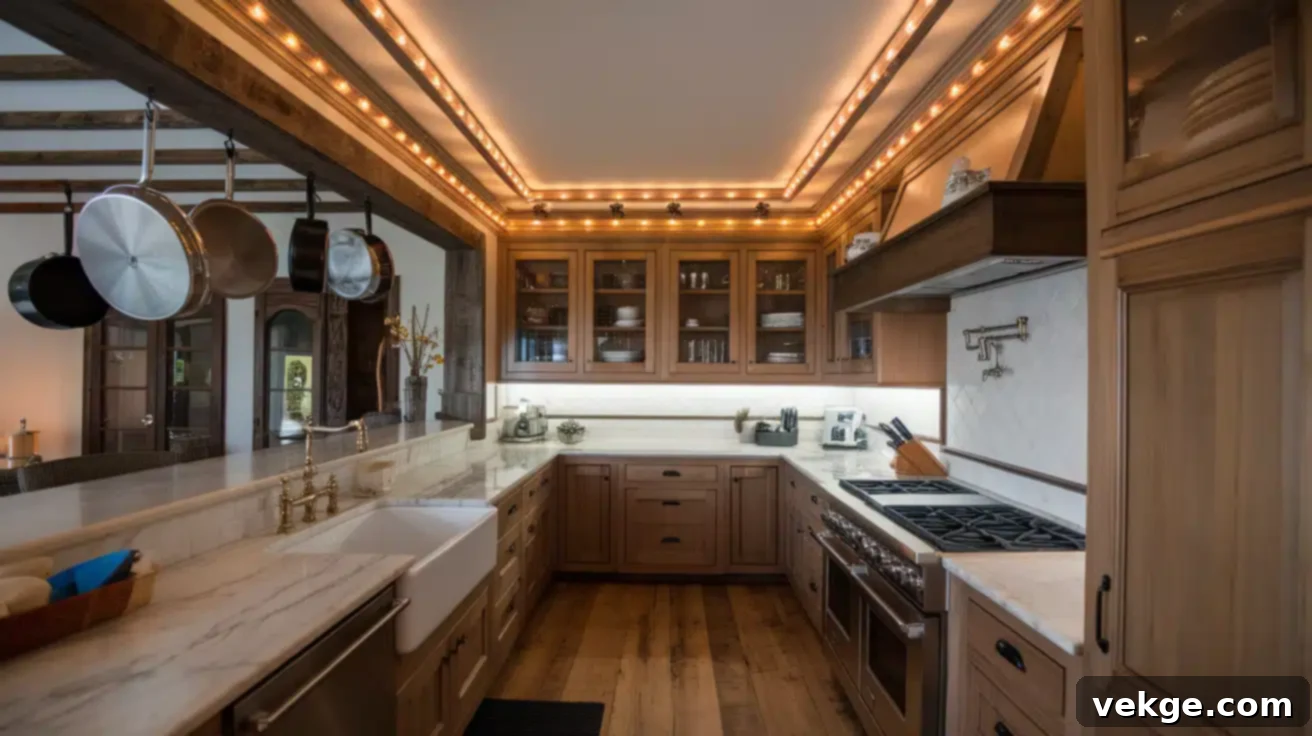
Why I Consider This Idea: I am particularly drawn to the soft, continuous, and even glow that rope lighting provides, especially when cleverly hidden behind cove or crown molding. It’s an ingenious way to introduce a touch of subtle drama and sophisticated ambiance to my kitchen ceiling, creating an inviting “upscale” feel that’s both modern and timeless.
Benefits: This type of hidden lighting creates a wonderful warm, ambient glow that reflects off the ceiling, making the entire room feel more spacious and my ceilings appear taller. It’s also an excellent way to add indirect light without taking up any visual space with fixtures, maintaining a clean and elegant aesthetic. It’s perfect for setting a relaxed mood during dinner parties or simply enjoying a quieter evening at home, adding a layer of luxurious lighting that instantly enhances the overall appeal of the kitchen.
How to Install This: If you’re fortunate enough to have existing crown molding with a gap above it, you can often simply tuck the rope light discreetly behind it for an easy DIY installation. For true cove lighting, where the light is hidden within a custom architectural feature, you might need to build a small, recessed shelf or soffit along the top perimeter of the walls to conceal the light source and direct the illumination upwards. For either, ensure you use the appropriate mounting clips and connections. Always consider a professional if custom carpentry or electrical work is needed.
Longevity: Modern LED rope lights are highly durable and energy-efficient. They typically boast a lifespan of 25,000 to 50,000 hours, which means they can provide beautiful ambient lighting for many years – potentially over a decade – before needing replacement. Their enclosed design also makes them relatively resilient to dust and moisture, contributing to their long-term performance.
16. Motion-activated Pantry Lights: Convenience at Your Fingertips

I absolutely adore the sheer convenience and smart functionality of lights that turn on automatically when I open my pantry door. This simple yet highly effective solution makes it incredibly easy to find exactly what I need, quickly and without fumbling for a switch. It’s a small detail that dramatically improves the usability of a frequently accessed area. It also cleverly saves energy because I never have to remember to turn off the light; it simply does it for me!
For an easy and budget-friendly installation, I often recommend using battery-operated, stick-on LED lights equipped with built-in motion or door-sensor switches. These are typically very simple to install myself, requiring no complex wiring or electrical knowledge, making it a perfect DIY project. They provide instant, targeted light precisely when and where it’s needed within the pantry, transforming a potentially dark corner into an organized and brightly lit space.
Longevity: The battery life for motion-activated pantry lights typically ranges from 6 months to 2-3 years, depending on usage frequency and battery quality, before needing replacement. The LED bulbs themselves, however, are exceptionally long-lasting, often boasting a lifespan of 25,000 to 50,000 hours. So, while you’ll swap batteries periodically, the light source itself will endure for many years, providing reliable, hands-free illumination.
17. Color-Changing Smart Bulbs: Dynamic and Personalized
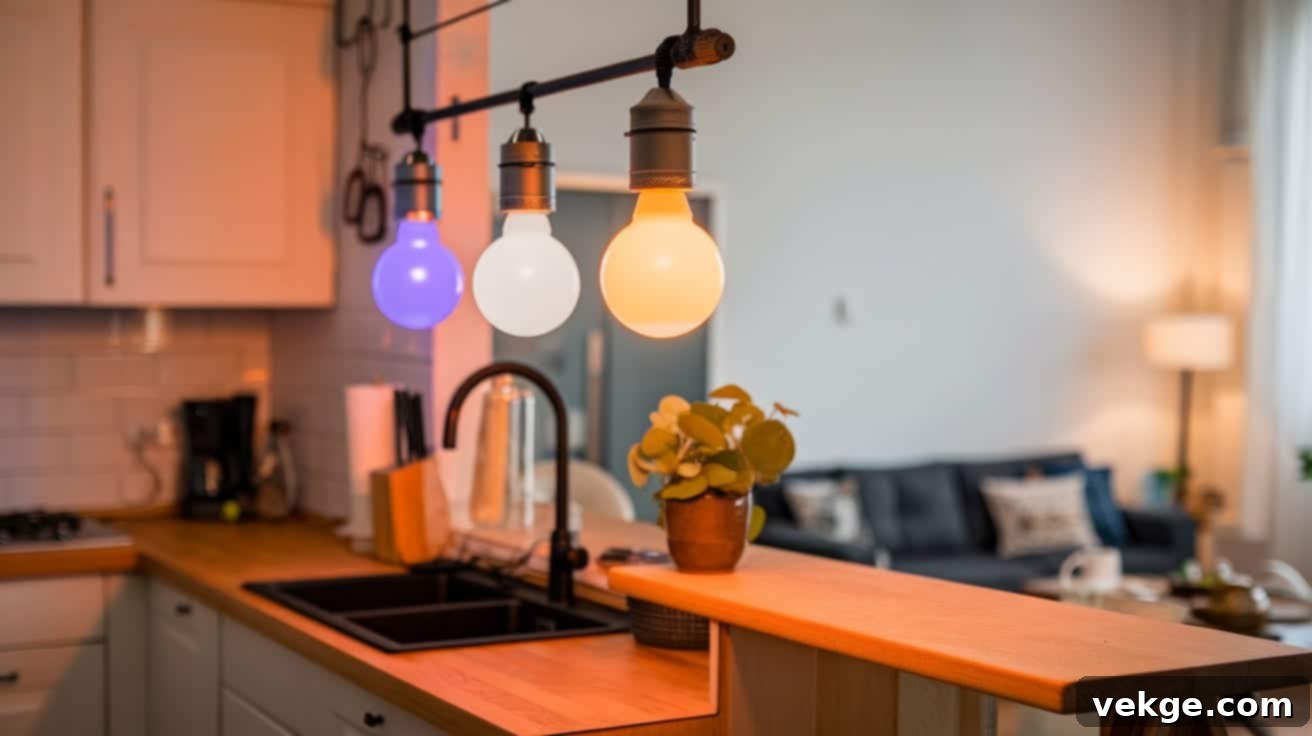
Why I Consider This Idea: For those who love technology and personalization, color-changing smart bulbs are an exciting addition to the kitchen. I particularly appreciate the incredible flexibility of being able to effortlessly change my kitchen’s entire color scheme and brightness with just a tap on my phone or a simple voice command. It’s a modern touch that brings unprecedented dynamic control to your lighting.
Benefits: The biggest advantage is the ability to adjust the lighting to perfectly suit any mood or occasion. Whether I want a bright, cool white for morning prep, a warm, inviting yellow for dinner, or even festive colors for parties or holidays, smart bulbs deliver. They add a fun, playful element while also offering practical benefits like dimming capabilities and scheduling. They can truly transform the atmosphere of your kitchen in an instant, making it the most versatile room in your home.
Longevity: Color-changing smart bulbs are typically LED-based, inheriting the impressive longevity of LED technology. They can last up to 25,000 hours, which, with an average of 8 hours of daily use, translates to approximately 8 years. While they might be a slightly higher initial investment than traditional bulbs, their extended lifespan, energy efficiency, and dynamic capabilities make them a worthwhile and long-lasting upgrade for a modern kitchen.
Installation & Practical Tips for Smart Lighting
Integrating smart lighting into your kitchen, especially with color-changing bulbs, offers a world of convenience and customization. Here are some essential tips to help you get started and make the most of your smart lighting setup:
- Choosing the Right Bulb Type: It’s crucial to select smart bulbs that are compatible with your existing fixtures. I always double-check if the base type (e.g., E26 for standard lamps, GU10 for track lighting, BR30 for recessed lights) fits. Compatibility with dimmers is also key.
- Tip: Look for “dimmable” and “wet-rated” or “damp-rated” if installing in areas exposed to steam or moisture (like over the sink). Investing in quality smart bulbs upfront saves headaches later.
- Setting Up Smart Controls: Once you have your bulbs, the next step is to pair them with your preferred smart home system (like Google Home, Amazon Alexa, Apple HomeKit, or a dedicated hub). This allows you to control them via your smartphone, tablet, or voice commands.
- Tip: Smart bulbs rely heavily on a stable Wi-Fi connection. If you experience connectivity issues in your kitchen, you might need to move your Wi-Fi router closer or consider a Wi-Fi extender for better coverage and seamless operation.
- Energy Efficiency and Cost: Prioritize LED-based smart bulbs. While their upfront cost might be slightly higher than traditional bulbs, the long-term savings are substantial.
- Tip: LED smart bulbs consume significantly less power and last many times longer than incandescent bulbs. My energy bill saw a noticeable decrease after I made the switch to a fully LED smart lighting setup in my kitchen. You can also program them to turn off when not in use, further optimizing energy consumption.
Choose the Right Lighting Style for Your Kitchen
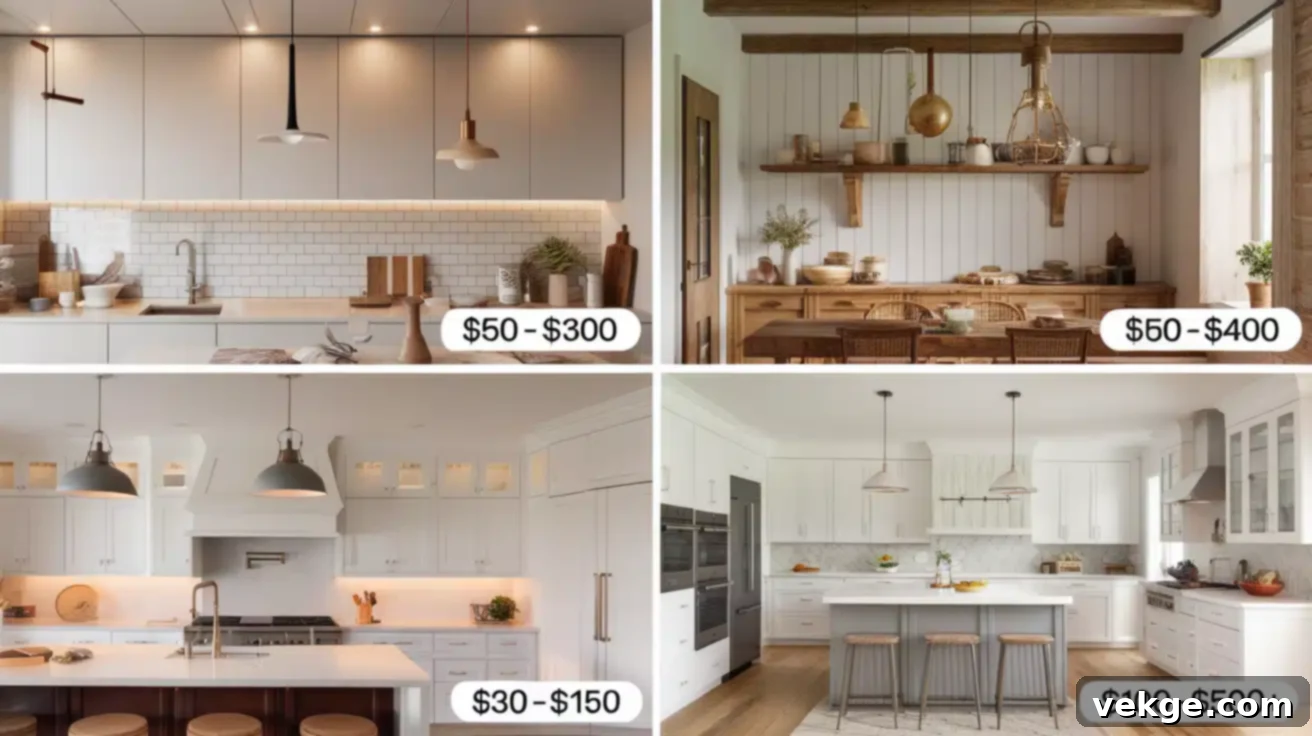
The right lighting should not only illuminate but also complement your kitchen’s unique style. Here’s a look at how different lighting choices harmonize with popular kitchen aesthetics:
| Kitchen Style | Description & Lighting Suggestions |
|---|---|
| Modern Kitchen | Characterized by sleek, clean lines, minimalist decor, and often glossy finishes with stainless steel appliances. For this style, opt for recessed lighting for general illumination, slim LED under-cabinet strips for task lighting, and geometric or minimalist pendant lights over an island or peninsula. Consider cool white (4000K) or neutral white (3500K) light temperatures to enhance the crisp, clean look. |
| Farmhouse Kitchen | Exudes warmth, coziness, and a rustic charm, often using natural materials like wood, reclaimed elements, and antique-inspired fixtures. Lighting here should be inviting and functional. Think barn-style pendant lights or lanterns over the island, vintage-inspired flush mounts, and warm LED under-cabinet lighting (2700K-3000K). Exposed bulb Edison-style fixtures can also add character. |
| Contemporary Kitchen | A blend of modern and traditional elements, focusing on current trends, functionality, and comfort. It adds elegance with classic shapes and materials, often incorporating innovative design. Layered lighting is key: recessed lights for ambient, chic linear pendants or a statement chandelier over an island, and sleek track lighting for flexibility. Dimmers are a must to transition from task to ambient moods. |
| Open-Plan Kitchen | These kitchens merge cooking, dining, and living areas, requiring a sophisticated mix of lighting styles to define different zones while maintaining a cohesive flow. Use general overhead lighting (recessed or flush mount) for the entire space, distinct pendant lights to delineate the island or dining area, and wall sconces or accent lights to highlight specific features or create intimate seating zones. Ensure light temperatures are consistent across zones or easily adjustable with smart bulbs. |
Different Types of Bulbs that Suit Your Home
Choosing the right bulb type is just as important as selecting the right fixture. Each type offers distinct characteristics in terms of light quality, efficiency, and color temperature. Understanding these differences will help you illuminate your kitchen perfectly:
1. LED (Light Emitting Diode)
- Color Temperature: 2700K – 5000K (Warm White to Cool Daylight)
- Description: LEDs are the reigning champions of efficiency. They are incredibly energy-efficient, boast an exceptionally long lifespan, and are available in a vast array of styles, brightness levels, and color temperatures. Most modern LEDs are dimmable, offering great flexibility. They produce very little heat.
- Best Use: Ideal for virtually all kitchen lighting needs, including general ambient lighting, intense task lighting (like under-cabinet or recessed), accent lighting, and decorative fixtures. They are perfect for long-term, low-maintenance solutions.
2. Incandescent
- Color Temperature: ~2700K (Very Warm White)
- Description: Known for their classic warm, cozy, and familiar glow. However, they are far less energy-efficient than LEDs, converting most energy into heat rather than light, and have a much shorter lifespan.
- Best Use: Primarily for ambient or accent lighting where a very specific warm, soft glow is desired, and energy efficiency is less of a concern. Often used in decorative fixtures that showcase the bulb itself.
3. Halogen
- Color Temperature: 3000K – 3200K (Warm to Neutral White)
- Description: Halogen bulbs offer bright, crisp, natural-looking light with excellent color rendering (making colors appear true-to-life). They are more efficient than incandescent but less so than LEDs, and they also generate significant heat.
- Best Use: Excellent for focused task lighting, such as under-cabinet puck lights or track lighting, where accurate color rendering is important for food prep. Can also be used for accent lighting to highlight specific features.
4. Fluorescent (Linear/Tube)
- Color Temperature: 3500K – 5000K (Neutral to Cool White)
- Description: These provide bright and cost-effective illumination over large areas. They can offer a cooler white light, which is efficient but might not be as warm as preferred for residential kitchens. They contain mercury, requiring special disposal.
- Best Use: Best suited for general lighting in larger, utilitarian kitchens or utility areas where broad, efficient light is the priority, and the aesthetic is secondary. Less common in modern residential kitchens.
5. CFL (Compact Fluorescent Lamp)
- Color Temperature: 2700K – 5000K (Warm White to Cool Daylight)
- Description: CFLs are energy-efficient alternatives to incandescent bulbs, lasting longer and using less power. They are available in various shapes and color temperatures, but often have a slight warm-up delay and, like linear fluorescents, contain mercury.
- Best Use: Can be used for general and ambient lighting in fixtures designed for standard screw-in bulbs. While more efficient than incandescent, LEDs are now generally preferred for their instant-on, superior dimming, and mercury-free nature.
6. Smart Bulbs
- Color Temperature: 2700K – 6500K, RGB (Full Spectrum)
- Description: Typically LED bulbs with integrated Wi-Fi or Bluetooth connectivity, allowing for customizable color, brightness, and scheduling via an app or voice control. They offer unparalleled flexibility in creating specific moods or themes.
- Best Use: Ideal for mood lighting, flexible kitchen lighting setups where ambiance is paramount, or for those who desire smart home integration. Perfect for dining areas, accent lighting, or general lighting where dynamic control is desired.
What is the Best Lighting for a Small & Large Kitchen?
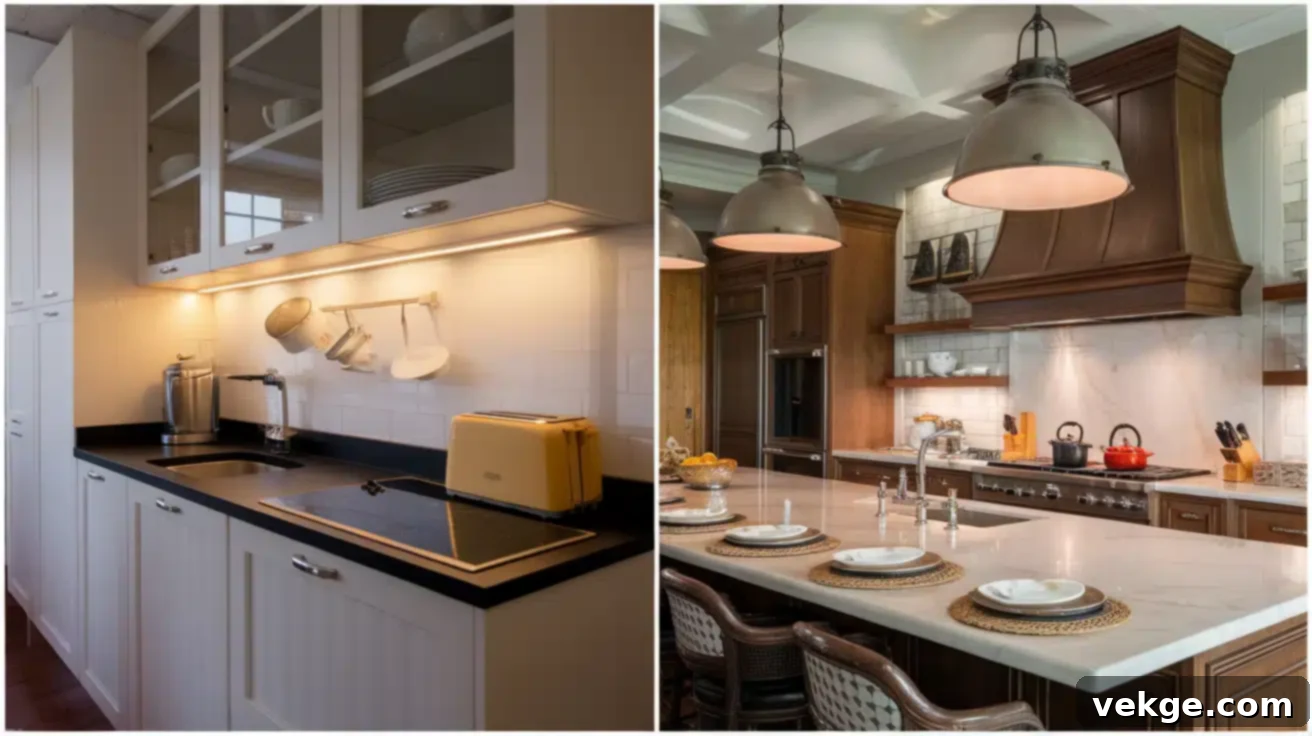
The size of your kitchen plays a significant role in determining the most effective lighting strategy. While layering light is always a good principle, the types and scale of fixtures will vary dramatically between small and large spaces.
Small Kitchen
In a small kitchen, the goal is to maximize space, avoid clutter, and create a sense of openness. Space-saving and efficient lighting are key to making the room feel larger and brighter. Here are some ideal options:
- Flush Mount or Semi-Flush Mount Ceiling Lights: These fixtures sit close to the ceiling, providing excellent general, even lighting without hanging down and encroaching on vertical space. They are superb for kitchens with lower ceilings and contribute to an uncluttered, more open feel. Choose simple, clean designs.
- Under-Cabinet LED Lights: Absolutely essential for small kitchens. They provide crucial task lighting for countertops, eliminating shadows cast by overhead lights and making prep areas highly functional. This also helps the kitchen feel larger and brighter by illuminating dark corners.
- Recessed Lighting: An ideal choice for general illumination as they are installed directly into the ceiling, keeping the ceiling line completely uncluttered. This maximizes vertical space and provides a clean, modern aesthetic that makes small kitchens feel more expansive. Use several strategically placed lights for even coverage.
- Mini Pendant Lights (for Countertops or Islands): If you have a small breakfast bar or a very compact island, a single, slim, or mini pendant can add a touch of style and focused light for dining or quick tasks without overwhelming the space. The key is to choose slender designs that maintain an airy feel.
Tip for Small Kitchens: Utilize light-colored finishes and reflective surfaces (like glossy tiles or stainless steel) to help bounce light around the room, further enhancing the sense of space and brightness.
Large Kitchen
For a larger kitchen, you have more flexibility, but the challenge is to avoid a “big box” feeling by creating distinct zones and a balanced, multi-layered lighting scheme. You’ll want a combination of fixtures to cover different functions and aesthetic goals.
- Recessed Ceiling Lights: These form the foundational layer of ambient lighting. Use multiple recessed lights, spaced evenly, to provide broad, consistent, and even illumination across the entire expansive space. They are unobtrusive and versatile.
- Pendant Lights Over Islands or Dining Areas: Perfect for creating a strong focal point and adding significant style. In a large kitchen, you can opt for larger, more dramatic pendants or group two or three medium-sized lights over a substantial island or dining table. They define these zones beautifully.
- Track Lighting: Offers incredible flexibility in larger kitchens. Install it to direct light to different areas as needed, highlighting specific zones like the stove, a particular prep area, or a unique architectural feature. It’s excellent for adaptable task and accent lighting.
- Chandeliers or Statement Lighting: In a truly spacious kitchen, a larger chandelier can serve as a magnificent focal point, adding grandeur and elegance. Position it strategically over an island, a dining table, or in the center of a large open area to add style and a warm, inviting glow.
- Under-Cabinet and Toe Kick Lighting: These are crucial for layering light in a large kitchen. Under-cabinet lights provide essential task lighting for counters, while toe kick lighting adds a subtle, modern glow near the floor, enhancing depth and creating a welcoming, finished look.
For both small and large kitchens, always consider using dimmable lights for all your fixtures. This flexibility allows you to effortlessly adjust the brightness and mood based on the time of day, the activity at hand, or simply your personal preference, enhancing both functionality and ambiance.
Maintenance Tips You Must Consider for Kitchen Lighting
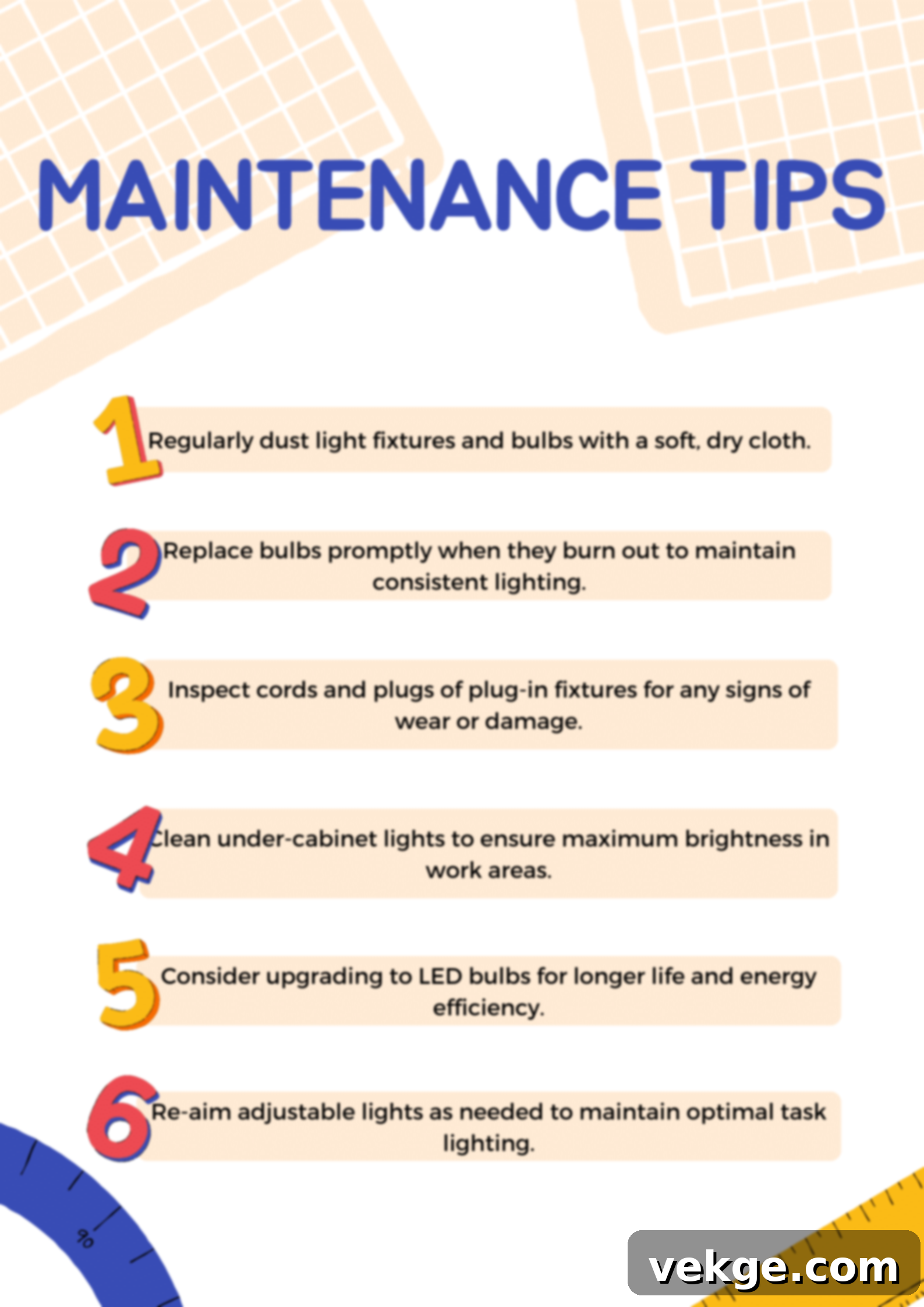
To ensure your kitchen lighting remains bright, beautiful, and safe for years to come, regular maintenance is essential. Here are key tips to keep your illumination in top condition:
- Regular Cleaning: Dust and grease accumulate quickly in a kitchen. Regularly wipe down light fixtures, shades, and bulbs with a soft, damp cloth (ensure power is off). This prevents dulling of light and reduces fire hazards. For glass shades, use a non-abrasive cleaner for streak-free shine.
- Bulb Replacement Schedule: Keep spare bulbs on hand. While LEDs last a very long time, other bulb types will need replacing. Replace all bulbs in a multi-bulb fixture at the same time for consistent light output, especially for pendants or track lighting.
- Check for Loose Connections: Over time, vibrations or temperature changes can loosen electrical connections. If you notice flickering lights, turn off the power at the breaker and carefully check connections in easily accessible fixtures. For anything complex, always call a certified electrician.
- Inspect Wiring (Periodically): Once every few years, it’s wise to have an electrician do a quick check of your kitchen’s electrical wiring, especially for older homes or if you’ve added new appliances. This ensures everything is up to code and safe.
- Understand Your Dimmers: If you have dimmer switches, ensure you’re using bulbs compatible with them. Using non-dimmable bulbs on a dimmer can cause flickering, buzzing, or shorten the bulb’s lifespan.
- Address Flickering Immediately: Flickering lights can be a sign of a loose bulb, a faulty fixture, or an electrical issue. Always investigate promptly to prevent potential hazards or further damage.
- Clean Exhaust Fan Lights: The lights integrated into your range hood or exhaust fan are prone to grease build-up. Follow your manufacturer’s instructions for cleaning these lenses and bulbs to maintain their effectiveness.
- Know When to Upgrade: If your fixtures are old, corroded, or constantly failing, it might be more cost-effective and safer to upgrade to newer, more efficient models (like LED-integrated fixtures) rather than continuously repairing them.
Conclusion: Let Your Kitchen Shine!
So there you have it – a comprehensive guide filled with brilliant ideas for lighting up your kitchen! From the very first electric light bulb installed in a private residence in J.P. Morgan’s home in 1880, we’ve certainly come a long way. Today, the possibilities are endless, allowing us to perfectly tailor illumination to our needs and tastes.
Remember, the right lighting truly has the power to transform your kitchen from drab to fab. Whether it’s targeted task lighting that keeps your fingers safe while precisely chopping vegetables, or soft ambient lighting that sets the perfect mood for those indulgent midnight snack adventures, every layer of light plays a crucial role. It’s about creating a space that feels both highly functional and wonderfully inviting.
Ultimately, your kitchen lighting should work as hard as you do, and look good doing it! Whether you’re a seasoned DIY dynamo eager to tackle a new project or you prefer to leave the intricate wiring to the seasoned professionals, there’s a perfect lighting solution waiting to be discovered for your unique space and personal style.
Are you ready to truly light up your culinary world and unlock the full potential of your kitchen? Go forth and illuminate! And don’t forget to share your dazzling kitchen lighting makeovers with us – we’d absolutely love to see your bright ideas in action and how you’ve brought light and life to the heart of your home!
